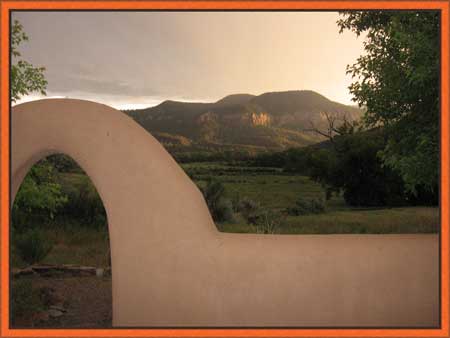 Sanctuary
SanctuaryMy boss’ 1962 Chevy Corvair does not have air conditioning nor does it have a radio. The 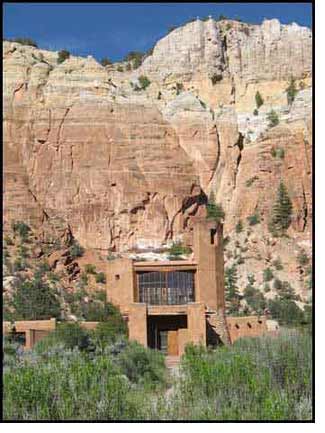 speedometer is 20 mph off the mark and the gas gauge does not work. The engine spews noxious fumes on the passenger side and the bucket seats are a marvel of ergonomic torture.
speedometer is 20 mph off the mark and the gas gauge does not work. The engine spews noxious fumes on the passenger side and the bucket seats are a marvel of ergonomic torture.
From a distance, however, Carl Baum’s Corvair looks like a pristine collector’s car and that’s one of the reasons why I jumped on the chance to “ride shotgun” on a recent journey to the Christ in the Desert Monastery, located in Northern New Mexico.
You see, Carl recently gave the monks a generous sum of money and they invited him to visit the monastery as a VIP. I was welcomed as his assistant and the two of us made the two-hour drive from Albuquerque to Abiquiu in a car that Ralph Nader once called “unsafe at any speed.”
We were supposed to arrive at the nearby Ghost Ranch in Georgia O’Keeffe country by noon but made a wrong turn in Espanola and headed half way up to Taos. After we doubled-back and got on the right road, we suddenly heard a loud knock under the hood. The car slowed down to 10 mph and we began backing up traffic for miles on steep mountain roads. Angry honks and obscene finger gestures filled the air.
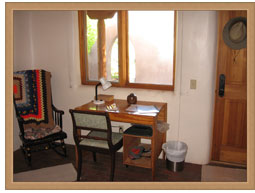 When we finally arrived at Ghost Ranch Museum, our pre-arranged meeting point, two hours late, we had lost three quarts of oil. While we were waiting to be met by our contact from the monastery, Carl inspected the engine (located in the back of the car) and noticed a piston and a spring that had flown out of its housing. He stuffed it back into place and screwed on the valve cover.
When we finally arrived at Ghost Ranch Museum, our pre-arranged meeting point, two hours late, we had lost three quarts of oil. While we were waiting to be met by our contact from the monastery, Carl inspected the engine (located in the back of the car) and noticed a piston and a spring that had flown out of its housing. He stuffed it back into place and screwed on the valve cover.
Brother Rodrigo arrived at around 3 p.m. A friendly fellow with a beard and baseball cap, he listened intently to our tales of woe. He told us that he had been driving behind us for a few miles as we limped up the road, unaware that we were in the car.
We transferred into the church’s heavy-duty SUV and we were driven to the monastery over 13 miles of treacherous, winding dirt road, along the scenic rapids of the Chama River and through the spectacular scenery that makes up the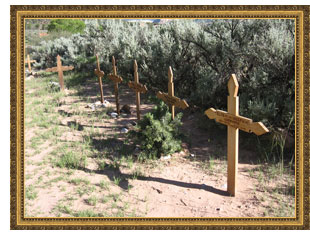 neighboring Carson National Forest.
neighboring Carson National Forest.
When we arrived at the monastery grounds the roads got even worse. Brother Rodrigo told us about cars that had slipped off the road or gotten their oil pans destroyed, or their frames bent after bottoming out.
We were given a tour of the grounds, the church, our lodgings and the dining hall (known as “the refectory”). Every detail of this monastery appears to have been very well thought out. From the hardware on the doors, to the state-of-the-art equipment in the laundry room and the enormous stove in the kitchen, everything was first class and top-of-the-line.
One of my favorite details of all is the enormous glass window in the refectory, which has a sort of flowing abstract design. Opposite that, on the wall, is a mural depicting a visitation of angels to a group of adoring worshippers, painted in the Greek Orthodox tradition of realistic faces and glowing gold leaf halos. 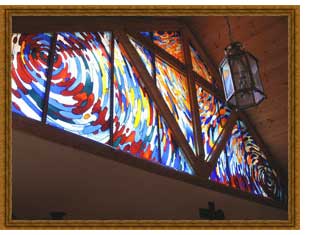
Carl was given the deluxe VIP suite close to the sanctuary and the cloisters, where the monks live. He has a private bath, reading materials, bottles of water and other amenities. I was given a room closer to the Chama river, in the old ranch house that was the original sanctuary. Although I do not have a private bathroom, I do have a spectacular view, two beds to myself and plenty of storage space.
I feel very safe here and feel no need to lock or even close my door. It is so quiet I can hear myself breathe. I can hear birds sing and coyotes bark. There are no TVs, radios or operational cell phones to disturb the peace and it is easy to focus on one’s tasks. I can walk around in my sandals (which seems to be the preferred footwear around here) and dress casually.
The monastery of Christ in the Desert was founded in June 1964 as a Benedictine community. There are about 30 monks here and about a dozen nuns living in a fenced stockade down the road. The monks live a very structured life of prayer. “Our day,” says the printed history left for visitors, “is divided betwee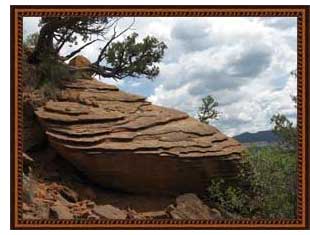 n times of prayer in common, blocks of time for private prayer and reading, the daily manual labor and some relaxation.”
n times of prayer in common, blocks of time for private prayer and reading, the daily manual labor and some relaxation.”
The monk’s manual labor consists of working in the laundry, the kitchen, maintaining the vast solar panel power system (the largest private system of its kind in New Mexico) and attending to dozens of other essential chores. As a visitor, I thought I was going to be scrubbing floors, but it seems that my only duties are simply to water the beautiful flowers in front of my little house and to look after Carl.
So far I have enjoyed attending Vespers and the Compline. I sang along with the Monks in English, set to the music of Gregorian chant. The church itself is a magnificent piece of architecture, with a high ceiling constructed of delicate latillas (unpeeled, rough sticks), supported by mighty vigas (roof beams made of trimmed and peeled tree trunks). A multitude of windows fill the spacious room with light. The monks are separated into two groups along the side of the church and when they sing, they chant a line or two that is answered by the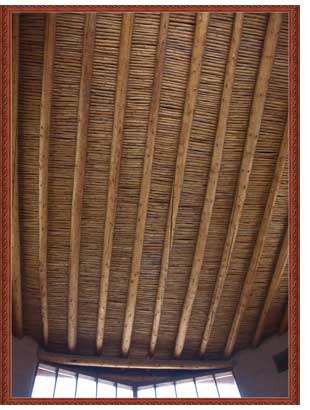 opposing choir.
opposing choir.
The evening meal couldn’t come too soon since we missed lunch and I foolishly started the day with a light breakfast. Dinner consisted of a large piece of bread that had been cut into individual pieces, rice, a very tasty mushroom/tomato soup concoction, salad and cheese, set to the background music of a lively trumpet concerto.
Although the meal may seem to be somewhat frugal, it certainly does not appear as though anybody is going hungry around here. Most of the monks seem quite well fed, judging from their waistlines.
Silence seems to be a big deal at this place and I find that quite agreeable, actually: When people don’t talk, they can’t really bicker with each other.
As the day comes to an end and darkness falls upon this beautiful valley, I think I will spend the rest of the evening studying The Rule of St. Benedict, a compact little red book that just happens to be sitting on my night table.
8 a.m. Saturday morning
“Lauds” begins at 5:45 a.m. It was difficult for Carl to sleep through this because the church bell is situated right above his sleeping quarters. Even I could hear its persistent clanging from my room by the river, so I got dressed and attended the service.
The monks were wearing white hoods this morning. The service was conducted in English Gregorian chant, but this time quite a bit of Latin was thrown in at the end.
I decided to take communion this morning for the first time in my life. I figured what the heck, “when in Rome do as the Romans do.” A line formed near the front of the altar where the priest handed us “the body of Christ”. It was a small round c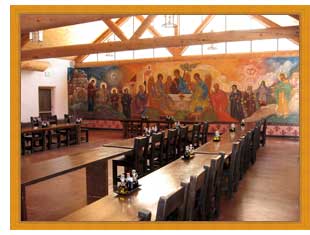 racker, minus the salt, with a large cross in the middle. I let the wafer sit and dissolve in my mouth and, like most of the ceremony here, it sent tingles up and down my body.
racker, minus the salt, with a large cross in the middle. I let the wafer sit and dissolve in my mouth and, like most of the ceremony here, it sent tingles up and down my body.
As I was sitting through the service, I became distracted by all the little architectural details around me. The windows, facing the rocky cliffs, were a welcome sight, as were the woodcarvings, the stone altar and even the earthen floor of the chapel.
As the service progressed I felt my stomach gradually rebel on me. Soon I was experiencing sensational intestinal trauma, caused no doubt, by my eating the body of Christ without having proper credentials to do so.
Noon.
Brother Bernard, an older gentleman, gave Carl and me an extensive tour of the monastery, including parts that people rarely get to see, like the cloister (where the monks actually live) and the woman’s portion of the convent, affectionately referred to as the Monastery of Our Lady in the Desert which, it was pointed out to me with a sly smile by one of the brothers, made up the acroynm “MOLD”.
Every monk has his own little cell. Two cells make up a room that shares a common bathroom. The cloister is one of the newer parts of the compound and connects with the sanctuary through spacious corridors. Most of the rooms are radiant heated by pipes running underneath the floor. Brother Bernard showed us the control room for the radiant heat and I was very impressed by its sophisticated, yet elegant, means of operation.
Brother Bernard was full of stories, like the one where Georgia O’Keefe made a label for use by the nun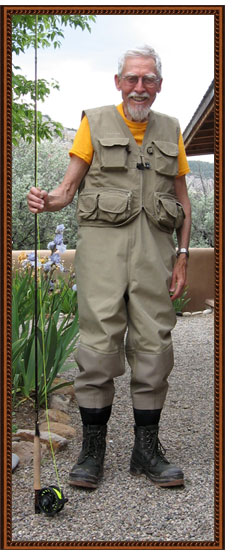 s and their handicrafts. Unfortunately that label, which would probably be worth millions these days, was lost and they have been looking for it ever since.
s and their handicrafts. Unfortunately that label, which would probably be worth millions these days, was lost and they have been looking for it ever since.
Brother Bernard told us about a 50-year-old hiker who fell off the mountain behind the church and died. (“It’s not the fall that will kill you,” interrupted Carl. “It’s the abrupt landing.”)
It seems many hikers have met their Maker in this region and this, quite frankly, has tempered my usual desire to summit these peaks.
Lunch
A fancy lunch was held in the refectory where the monks served us our food. After singing the usual prayers, a monk stood up behind a lectern in front of us and read verses from the Bible. Unfortunately he was reading one of those tedious, indecipherable passages where unpronounceable people journeyed to unpronounceable lands and begot a slew of unpronounceable offspring. Clearly, nobody was following.
This bible passage was followed by some intriguing commentary from a different text which concerned Martin Buber and a passage from his book called “I and thou.” The monk explained that “Thou” differs from “You” because “Thou” is the term that implies intimacy, sort of like the way the Germans use the formal “Sie” instead of “Du.” The monk illustrated the difference by explaining how a customer at a restaurant might react when he received an incorrect order. If the customer was insensitive, he said, he would treat the waitress as an “it” with absolutely no regard for her feelings. Ideally, he explained, it is important that we treat people as an “I and Thou” relationship because disastrous consequences can occur when people treat other people as an “it.”
He then went on to recount how Buber, when he first received his appointment as a professor, treated one of his students as an “It,” instead of being sensitive and compassionate. The professor was putting his own self-interests before those of his student. As a result of this, the student committed suicide and Buber had to go through life blaming himself for his death.
And just when things started to get interesting, the prior rang a little bell and the reading was over. Our empty plates were quickly removed and lunch was over.
Carl and I walked to the Chama River and had a lively discussion about popes, King James and all sorts of things. As we sat on an old log watching the rafters and river pass us by, Carl, at one point, turned to me and said, “Oh by the way, you’re not supposed to take Communion unless you’re a Cat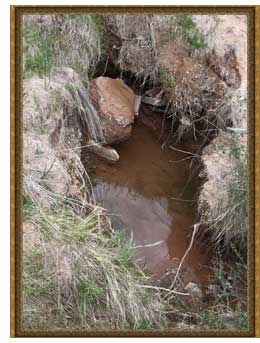 holic.” By this time my stomach felt as if it had been broiled over the coals of hell and I assured him that I would never ever do anything like that again.
holic.” By this time my stomach felt as if it had been broiled over the coals of hell and I assured him that I would never ever do anything like that again.
The monks live an incredibly structured life out here in the desert. The daily schedule consists of prayer sessions called “Vigils, Lauds, Terce, Sext, None, Vespers and Compline.” When they are not praying they have chores to do. And when they are not doing chores, they can occupy themselves by making crafts that will be sold in the bookstore.
The bookstore is definitely a “must see” place at the monastery because it has a very eclectic collection. The Thomas Merton section is by far the largest and I found a lovely collection of his “greatest sayings,” one for me and one for Jennifer. I also bought a small, full-color pamphlet describing this place, an essential piece of history for a writer like me who generally gets his facts messed up. I would have bought a steamy, riveting book called Harlots of the Desert, but priced at over $15, I just couldn’t justify the expense.
A Bible sits on my table as I write these words and about a half hour ago I cracked it open. I don’t think I have looked at a Bible for years but I thought I would open it at random.
It’s the New American Bible, published by the Catholic Book Publishing Company. Unlike the King James version, it has dispensed with all the “thees and thous” and embeds its message in very readable English.
I opened the Bible to the book of Sirach 26 and began reading and could not stop reading. If ever there was a book that laid down the rules of proper etiquette and behavior, this has got to be it! It also deals with the consequences of marrying a wanton woman, table manners and friendship.
I was going to spend my idle hours hiking and reading How to Win Friends and Influence People but quite frankly, right now, all I feel like doing is reading the book of Sirach (which, to be honest, reads very much like Dale Carnegie’s classic How-To book.)
“Wine is very life to man if taken in moderation,” reads the Sirach text, “Does he really live who lacks the wine which was created for his joy? Joy of heart, good cheer and merriment are wine drunk freely at the proper time. Headache, bitterness and disgrace is wine drunk amid anger and strife…. Rebuke not your neighbor when wine is served, nor put him to shame while he is merry; Use no harsh words with him and distress him not in the presence of others.” Sirach, 32.
Good stuff.
Uh oh, the church bell is ringing for Vespers. Got to go!
8:30 p.m.
The monastery’s sanctuary has a compacted dirt floor, is heated with wood during the winter and is flooded by light from scores of windows facing steep, craggy cliffs. The chairs, even with their worn-out cushions, are extraordinarily uncomfortable. But they could be worse: they could be bench seats.
My body is a wreck. Between 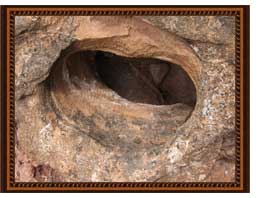 Carl’s worn out bucket seats and the austere chairs in the refectory and the chapel, as well as the rock hard mattress in my room, my bony butt and crooked spine are really taking a beating.
Carl’s worn out bucket seats and the austere chairs in the refectory and the chapel, as well as the rock hard mattress in my room, my bony butt and crooked spine are really taking a beating.
Add to that the suffocating incense of this evening’s Vespers and the evening meal, and you’re looking at a guy who is wondering if this is God’s idea of payback for having taken communion this morning.
The food. Let me say a few words about the food. Clearly, this is not The American Culinary Institute. If I have to look at another bowl of beans, another helping of pasta or another dollop of white rice or greasy hamburger concoction, my stomach might very well explode.
As as it is written in the book of Sirach, “If perforce you have eaten too much, once you have emptied your stomach, you will have relief.” (The footnote is particularly enlightening, i.e. “the practice of induced vomiting, well-known among pagan Romans, and less well-known among the Jews, seems to be referred to here.” Since I am, afterall, a Jew, I think I will just suffer. Maybe the Pepto-Bismal will kick in . . . )
After dinner and Compline, Carl and I sat outside the church and talked about interplanetary space travel, gravity and the Holy Trinity. I told Carl I had a hard time wrapping my mind around the concept of the Father, the Son and the Holy Ghost. This led into a discussion about metaphor and the role it plays in religion, as well as Adam and Eve and the knowledge of good and evil.
I asked Carl why he gave so much money to the monastery and what was the point in having them around in this day and age. He said, “It’s important that places like this survive and flourish because they act as a model for how people should live.”
When the sun finally set and we were starting to get cold, we went our separate ways.
7:30 a.m. Sunday
Thanks to the pink stuff, I was able to settle my stomach last night. If this was God’s vengeance for me taking communion, I certainly got the message loud and clear. I still felt restless, however, and needed a sleeping pill to finally get to sleep.
I woke up around 6:30 and felt shocked (and somewhat relieved) to see that I had missed the 4 a.m. Vigils and most of the 6 a.m. Lauds. I made my appearance right before the service ended and got “the look” from Carl and I responded with a mischievous smile. Later I asked him what I missed and he said that, among other things, “KP duty” had been assigned for the next week (in Gregorian chant, of course).
Staying at the Monastery of Christ is the Desert is a great place to become familiar with the Gregorian chant. Most of the prayers are sung to it and the ancient, musical notation generally accompanies the text, which has been photocopied and spiral bound. Unlike the Jewish services I have attended, page numbers are not announced. If you look really lost, a monk will note your confusion and help you find your place.
Most people sing along with th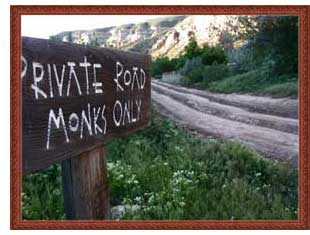 e monks and many, like myself, don’t sing very well and only have a vague idea of what those musical notes mean. Even the text is annotated with little symbols that tell you when to extend a note or raise or lower it. A tiny electronic organ will often pitch in at the beginning of a song to help us find the right key.
e monks and many, like myself, don’t sing very well and only have a vague idea of what those musical notes mean. Even the text is annotated with little symbols that tell you when to extend a note or raise or lower it. A tiny electronic organ will often pitch in at the beginning of a song to help us find the right key.
The monks spend about four hours a day praying and in the course of a week chant 150 Psalms. Most are sung in English but there is a surprising amount of Latin thrown in. Each prayer has its own distinct flavor and one phrase keeps popping up again and again, “As it was in the beginning, is now and ever shall be, world without end. Amen.”
Sunday.
Sunday is a big day at the monastery. Even the nuns in their black habits have appeared from their stockade in the back. The service was very elaborate, complete with burning incense, chanting monks and even a sermon about the Trinity from our host.
Brother Christian spoke about the Trinity and how difficult it was to comprehend. He told the story of how Saint Augustine met a boy on the beach who was trying to fill a hole in the sand. The boy told Augustine that he was going to place the entire ocean, handful by handful into the hole.
Augustine was about to tell the boy that such a task was impossible but at that moment he had an epiphany. He realized that the mind’s ability to comprehend the Holy Trinity was pretty much like the boy’s task of fitting the entire ocean into the hole.
The service ended with the congregation given a chance to speak up and briefly say what’s on their minds. One Georgia O’Keefe look-alike chirped up and asked for equality between men and women in the church. The congregation responded by singing, in a Gregorian chant-like fashion, “Lord hear our prayer.”
Prayers were made for saints, benefactors and even us, praying that we make it back to Albuquerque in one piece, after having practically blown up the engine of Carl’s Corvair.
I was tempted to insert a prayer of my own but did not. If I had had the courage it would have gone something like this:
“Please look kindly upon the machines that serve us and may they operate steadily and efficiently without interruption.”
A social hour followed the service and there I had the pleasure of meeting Brother John, an engaging young man in his late 20’s.
John has only been at the monastery for six months and prior to that went through his novice stage in Chicago. “A year and a half of Hell,” he called it. Now he is a Junior and he seems pretty comfortable with his situation, though he says his friends think he is crazy.
I told John that I had a difficult time wrapping my mind around the concept of the Holy Trinity. He could relate to my confusion and said that if there was anybody around here who said they could truly fathom the mystery of the Holy Trinity, that they were probably not speaking the absolute truth.
Every monk here has a story to tell and once you get to know them, you begin to realize that they are all very friendly people, each with an extraordinary life story.
3:45 p.m.
I just returned from hiking in the mountains, just as the sky began to cloud over, the thunder began to echo throughout the valley and the rain fell in heavy drops upon the parched landscape.
Visitors are reminded again and again not to hike in the nearby national forest (essentially their backyard), but I could not hold myself back. Although I am hardly a muscle man, I do consider myself an experienced hiker and headed out with sufficient water, heavy duty, well-broken in boots and a collapsible walking stick.
Three “legs” in such terrain are definitely better than two when it comes to maintaining one’s balance. I was using the stic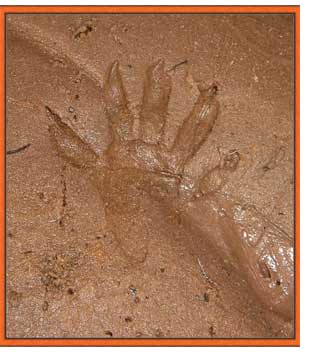 k constantly to keep myself from falling down the steep slopes. After establishing somewhat firm footholds, I drove the pole deep into the soft ground and that gave me an added advantage.
k constantly to keep myself from falling down the steep slopes. After establishing somewhat firm footholds, I drove the pole deep into the soft ground and that gave me an added advantage.
The land out here is like nothing I have ever seen in my 30 years of hiking in New Mexico. The ground itself, that red stuff you see in the O’Keeffe paintings, is actually dirt: Slippery-slidy, red dirt that probably turns into mud when it gets wet. A foothold turns into a landslide without much provocation.
The red rock is made of brittle sandstone material. The larger boulders have sharp cracks running through their lengths, threatening to fall on some hapless hiker at any time. The smaller rocks also have finely defined cracks running all the way through them. No small wonder why so many people who have hiked in this area have lost their lives.
I took a collapsible hiking pole along with me for my journey and I’m glad I did. Those who are proficient at technical climbing are probably the only people who should attempt climbing the majestic, looming rock behind the monastery. You definitely need ropes and pitons to get to the very top because I was not able to discern any trails at all. I’m sure they’re there somewhere, but I couldn’t find any, which I found to be odd, considering how long people have lived in this area.
One very pleasant thing I discovered during my two-hour hike was water!
As I climbed high above the monastery I could hear, in the crystal clear air, the sound of water. As I focused my senses it became louder and I eventually tracked the sound to a crevice from which water was dripping. As I looked around I saw water dripping from other places as well. And as I followed the path that the water was describing, I suddenly found myself at a series of ponds. Not puddles, mind you, but little ponds full of cold, fresh water. I splashed it on my face, hands and neck and it revived me enough to realize that it was time to head back to the monastery, lest my luck run out.
Father Fred, a retired priest from the Santa Fe Diocese, was standing on the porch of the ranch house, trying to take off some brand new Orville waders. Nearby was a brand new fishing rod.
Father Fred moved into the ranch house yesterday for a week. I heard him mill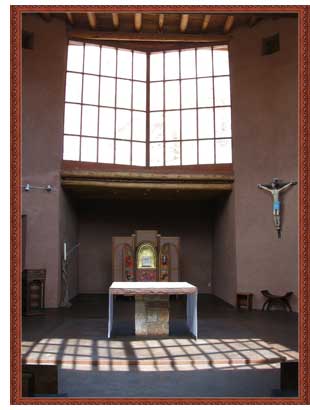 ing around but never really spoke to him. The sight of that old guy in those brand new waders was a sight and I asked him if I could take his picture. He was delighted with the idea and asked me if I could send him a print in the mail. No problem, I told him.
ing around but never really spoke to him. The sight of that old guy in those brand new waders was a sight and I asked him if I could take his picture. He was delighted with the idea and asked me if I could send him a print in the mail. No problem, I told him.
It seems Father Fred had a rather awful experience at the Chama River when he decided to try out his new duds. As he attempted to settle himself in the river, he quickly began sinking up to his knees in the soft mud. Somehow or other he extracted himself from that goo and now he was berating himself for having spent “a God-awful amount of money” on an outfit that he could not return for a refund.
Well, at least he’s going to get a picture out of it!
5:15 p.m.
Dinner was a splendid affair, by far the fanciest and most delicious so far. Chicken, corn on the cob and, for dessert, pecan pie graced our plates, served to us by the monks. I was so thirsty from my hike that I drank four large cups of water.
The reading was by a man named Krushner, a charming book called God is my Shepherd. The author spoke about friendship and love (two of my favorite subjects) and how a person is transformed when the object of his affection dies. It was a riveting passage and I can’t wait to get home and read the book at my leisure.
6:30 p.m.
Just returned from Solemn Vespers and Benediction. I suppose I’m getting better at chanting but I probably shouldn’t get a big head about it, especially after talking to young Brother John, a musicologist in his previous life, who seemed to suggest that there was a lot more to Gregorian chant than what I have been exposed to here.
At any rate, I’ve got a rare and intense education in the Benedictine Order and I’m a better man for it. I have spent the last 2-1/2 days without drugs, alcohol, TV and other earthly distractions. I have dedicated myself to celebrating the life, death and resurrection of Jesus Christ and, to be quite honest, I have found it an uplifting experience full of pageantry and symbolism.
I have surrounded myself with well-educated people who have come here from all over the planet, and I’ve engaged in lively and friendly conversation with many of them. I don’t think I am monk material, but I’m glad there are monks out there and I’m especially happy that they’ve let me share their life with them.
Outside, the thunder continues and sky holds the promi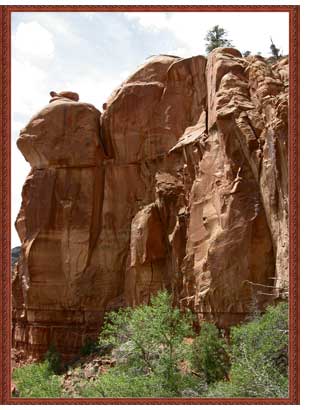 se of a downpour, yet all we are getting are sprinkles. The flowers, trees and grasses are releasing their aromas, making the world a much more beautiful and hopeful place.
se of a downpour, yet all we are getting are sprinkles. The flowers, trees and grasses are releasing their aromas, making the world a much more beautiful and hopeful place.
Epilogue
Carl and I somehow made it back to Albuquerque in one piece. We stopped along the road four times to reconstruct the engine and refill it with a gallon of oil that the Deacon had given us. Pistons and springs were consistently blown all over the engine compartment but we delicately rebuilt the engine about every 50 miles under the unforgiving New Mexico sun.
Thank you for visiting Chucksville.
|
|


